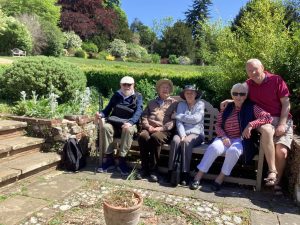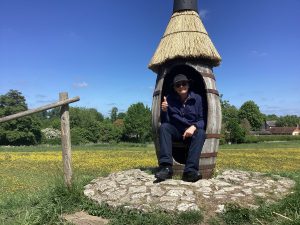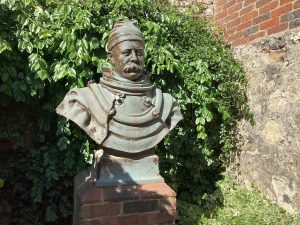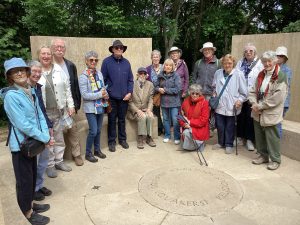What’s on : Activities
Event Information
YPS Tour to Hampshire
Thursday 15th to Sunday 18th May 2025
Cost from £569 per person (sharing) to include half board, one light lunch, return travel by executive coach, and visits and entrance fees as shown in the Itinerary. Single occupancy supplement: £90. YPS administration fee: £25 per person (to cover gratuities and other expenses). Optional insurance: £17 per person.
This 4 days, 3 nights’ stay with 3 choice, 3 course dinner and full English breakfast is based at The Norton Park Hotel, Spa & Manor House, Scotney, Winchester (4*), a lovely property set in 54 acres of parkland just outside the historic city of Winchester.
ITINERARY
Day 1: York to Winchester
0800: Depart York (Memorial Gardens, Leeman Road) and commence journey south to Kedlestone Hall for a visit and lunch stop. With a further refreshment break en-route we arrive at our hotel in Scotney, Winchester in the late afternoon. Time to settle into rooms before dinner.
Day 2: Jane Austen’s Chawton/Curtis Museum
Depart hotel after breakfast and travel to Alton for a visit to Chawton House. Please note: Coaches cannot access the main house and must drop off at the main gates where you will rejoin the coach on departure
A House Tour has been arranged for 1000 hrs, after which you will have some time at leisure before our included light lunch.
In the afternoon we travel to Alton to visit the Curtis Museum, boasting one of the finest local history collections in Hampshire, including a rare enamel Roman Cup and an impressive, ornate Anglo-Saxon buckle.
Introductory tour on arrival. *No entrance charge but £2 per person voluntary donation suggested for the upkeep of the Collection.
Day 3: Gilbert White’s House & Gardens/Winchester
Depart hotel and travel to Selborne for a visit to Gilbert White’s House & Gardens, the former home of Gilbert White and later Robert Washington Oates, a book collector and fan of natural history. The museum commemorates both Gilbert White and the Oates family, including Lawrence ‘Titus’ Oates, a decorated soldier and member of Captain Scott’s Antartica Expedition. There will also be time to explore the lovely gardens before departing for nearby Winchester, where you can visit the ancient Cathedral, or the National Trust’s centrally located Winchester City Mill.
Day 4: Winchester to York via The National Memorial Arboretum
Depart hotel after breakfast and travel to the National Memorial Arboretum, where we have an introductory tour. Depart in the afternoon and travel back to York, arriving at Memorial Gardens, Leeman Road in the early evening.
…………………………
Member’s report
Following weeks of almost unbroken sunshine, on a disappointingly grey, cloudy morning, our group of 29 left Memorial Gardens on our way south. First stop was Kedleston Hall (National Trust) near Derby. This mid-eighteenth century neo-classical building, designed by Robert Adam, was built for the Curzon family in order to impress and to compete with nearby Chatsworth, rather than with comfort in mind. The ultimate goal of the family of hosting royalty was, alas, never achieved. The Curzons came from Normandy at the time of William the Conqueror and are thought to have settled at Kedleston in the mid 12th century and today’s family still lives in a wing of the house. The current building replaced a more modest medieval building and village in the 1760s and was designed as a ‘Temple of the Arts’, referencing ancient Greece and Rome. Its most famous family member was George Nathaniel, Lord Curzon, who became Viceroy of India. As well as a large collection of art and fine 18th century furniture, displayed in the Hall is Lord Curzon’s impressively large collection of artefacts collected from many parts of Asia during his extensive travels in that continent.
From Kedleston we proceeded south, arriving at Norton Park Hotel, Sutton Scotney, just north of Winchester, where we spent three comfortable nights.
Next morning the sun returned for our morning visit to the village of Chawton, home to Jane Austen for the last 8 years of her life.  Chawton House, which we visited, is a delightful manor house originally built by the Knight family, and had been inherited by Jane’s brother Edward. This inheritance came about as a result of a series of childless marriages over the years, and ‘adoption’ by Thomas and Catherine Knight, wealthy distant relatives of George Austen, Edward and Jane’s father. Edward became their legal heir, and as stipulated, changed his name to Edward Austen Knight. He offered the use of a cottage in the village to Jane, her sister and her mother. This house, which we passed but did not visit, is now a museum to Jane. Chawton House is a short walk away from Jane’s cottage and she visited frequently, particularly using the library. We had two excellent guides who showed us round the house including the nook where Jane reputedly sat and read. An exhibition celebrating Jane and women writers who influenced or were influenced by her writing included some first editions of her books. Our visit concluded with a delicious lunch in the Great Hall.
Chawton House, which we visited, is a delightful manor house originally built by the Knight family, and had been inherited by Jane’s brother Edward. This inheritance came about as a result of a series of childless marriages over the years, and ‘adoption’ by Thomas and Catherine Knight, wealthy distant relatives of George Austen, Edward and Jane’s father. Edward became their legal heir, and as stipulated, changed his name to Edward Austen Knight. He offered the use of a cottage in the village to Jane, her sister and her mother. This house, which we passed but did not visit, is now a museum to Jane. Chawton House is a short walk away from Jane’s cottage and she visited frequently, particularly using the library. We had two excellent guides who showed us round the house including the nook where Jane reputedly sat and read. An exhibition celebrating Jane and women writers who influenced or were influenced by her writing included some first editions of her books. Our visit concluded with a delicious lunch in the Great Hall.
Onwards to nearby Alton to visit the Curtis Museum and the Allen Gallery. The Curtis Museum, opened in the mid 1800s, houses a fine local history collection covering from prehistoric to recent times. Undoubtedly the most impressive object is the Alton Buckle, an incredible piece of Anglo-Saxon workmanship found during an excavation as recently as 1960. The nearby Allen Gallery is housed in buildings last owned by William Curtis (founder of the Curtis Museum) whose will stipulated that they should be used as a public museum. Funds from the W H Allen bequest and from the County Council allowed its extension in 1979. It houses an extensive and impressive collection of mostly English ceramics – pottery, porcelain and tiles – together with some European and Asian examples.
The next day also dawned fine and sunny for our morning visit to Selborne, home to the 18th century clergyman, naturalist and keen  gardener Gilbert White. White spent his life observing and recording the natural world around him. His book, The Natural History and Antiquities of Selborne, first published over 230 years ago has never been out of print and his house has a collection of every edition ever published. The book consists of letters containing his observations which he exchanged with other like-minded naturalists. He has become known as the father of ecology, influencing later naturalists such as Charles Darwin. The grounds extend to 25 acres of which 5 acres form the delightful gardens which have been recreated using White’s ‘Garden Kalendar’.
gardener Gilbert White. White spent his life observing and recording the natural world around him. His book, The Natural History and Antiquities of Selborne, first published over 230 years ago has never been out of print and his house has a collection of every edition ever published. The book consists of letters containing his observations which he exchanged with other like-minded naturalists. He has become known as the father of ecology, influencing later naturalists such as Charles Darwin. The grounds extend to 25 acres of which 5 acres form the delightful gardens which have been recreated using White’s ‘Garden Kalendar’.
The house is also home to The Oates Collections which commemorate Frank and Lawrence Oates. This came about because the house was only able to be purchased and set up as a museum because of money donated by Robert Washington Oates who was also a keen naturalist. Lawrence Oates was an explorer and famously a member of Scott’s team to the South Pole who sacrificed his life in the hope of saving his fellow members of the team. Frank was a naturalist and explorer who travelled to the Americas and Africa, reaching the Victoria Falls but sadly dying on his return journey.
The afternoon found us in Winchester where the main attraction was the impressive cathedral. It is the longest medieval cathedral in  the world although slightly smaller in area than York Minster. Unlike York, it lost most of its stained glass during the English Civil War. Like York, it experienced severe problems with its structure and foundations, resulting in fears of collapse at the beginning of the 20th century. Trenches dug to try to work out what to do to remedy its perilous state filled with water from the nearby river. The building was only saved by the efforts of one man, William Walker, the most experienced diver of the time, who over a period of six years laid sufficient cement under water to stabilise the building. A remarkable achievement by one man, duly remembered by a statue in the cathedral and a bust outside.
the world although slightly smaller in area than York Minster. Unlike York, it lost most of its stained glass during the English Civil War. Like York, it experienced severe problems with its structure and foundations, resulting in fears of collapse at the beginning of the 20th century. Trenches dug to try to work out what to do to remedy its perilous state filled with water from the nearby river. The building was only saved by the efforts of one man, William Walker, the most experienced diver of the time, who over a period of six years laid sufficient cement under water to stabilise the building. A remarkable achievement by one man, duly remembered by a statue in the cathedral and a bust outside.
One of the most visited parts of the cathedral is the grave of Jane Austen with the nearby memorial plaque. At the time of our visit, this was marked by the most wonderful floral display of seasonal flowers.
The exhibition ‘Kings and Scribes’ includes two of six mortuary chests and the Winchester Bible. The mortuary chests contain collections of bones thought to be remains of pre-conquest bishops, kings and perhaps a queen. Over many years the bones have become muddled up with no complete skeletons remaining. Work is on-going to try to identify individuals within the chests who may include King William Rufus, William the Conqueror’s son, King Cnut and Queen Emma, who married two kings and was mother of two kings. On display is the magnificent Winchester Bible, the largest surviving bible of the 12th century which is profusely illuminated. It was probably commissioned by the Bishop of Winchester, Henry of Blois.
On our final day travelling back towards York we stopped at the National Memorial Arboretum in Staffordshire, which lies between  Burton-on-Trent and Lichfield, close to the midland motorway network. Part of the Royal British Legion, the 150 acre site, formerly gravel workings, was funded partially by the National Lottery together with many donations from a large variety of other organisations. It was developed to be a place of joy with living trees planted in remembrance of many organisations and groups, many military but not entirely so. Officially opened in 2001 it is a moving and inspirational place with over 25,000 rapidly growing trees and over 400 memorials spread over the site. Each memorial with its surrounding garden is carefully maintained by the organisation it honours.
Burton-on-Trent and Lichfield, close to the midland motorway network. Part of the Royal British Legion, the 150 acre site, formerly gravel workings, was funded partially by the National Lottery together with many donations from a large variety of other organisations. It was developed to be a place of joy with living trees planted in remembrance of many organisations and groups, many military but not entirely so. Officially opened in 2001 it is a moving and inspirational place with over 25,000 rapidly growing trees and over 400 memorials spread over the site. Each memorial with its surrounding garden is carefully maintained by the organisation it honours.
We arrived back in York having enjoyed four days of varied and interesting visits, mostly in good weather, which went smoothly thanks to the meticulous organisational skills of our leader, Dorothy Nott to whom we say a big thank you!
Agnes Winter
Photos: Dorothy Nott (In the garden of Chawton House; Gilbert White’s hide; Bust of William Walker; Quaker Memorial at National Memorial Arboretum)

